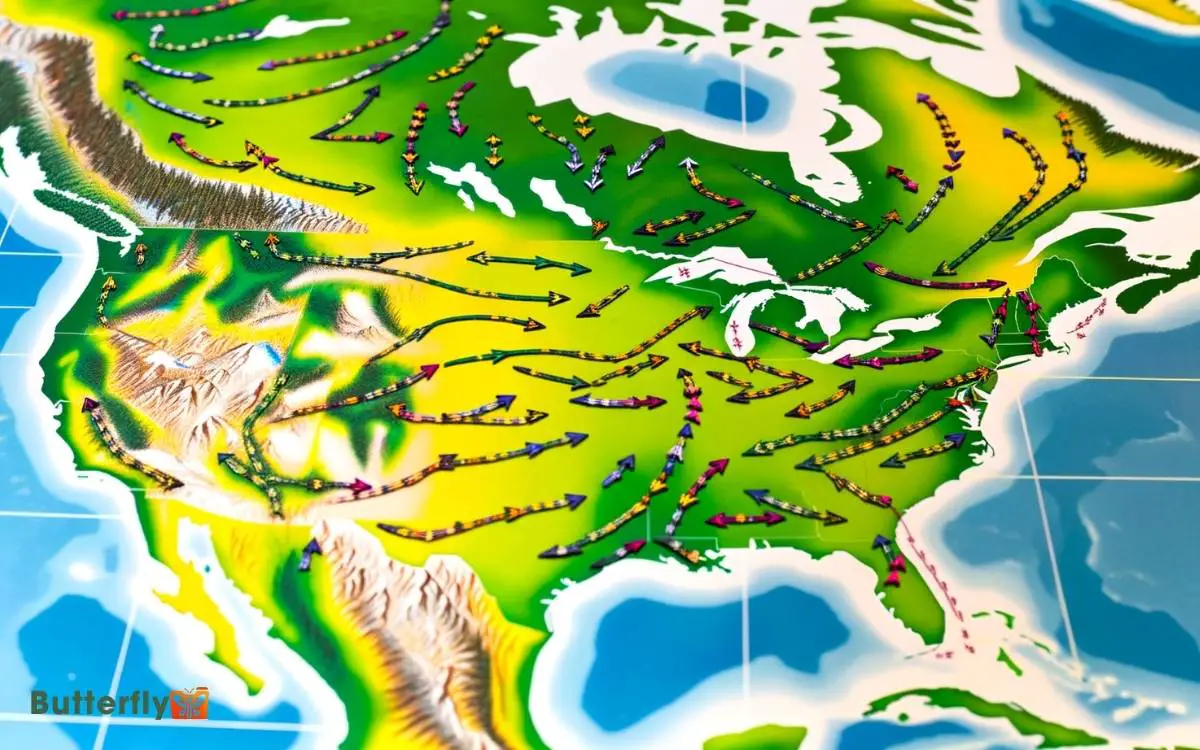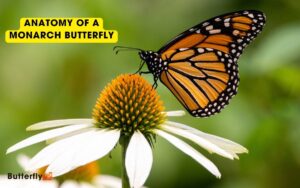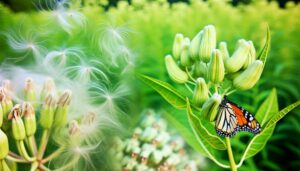Map of Monarch Butterfly Migration: Discover the Journey!
Monarch butterflies undertake an astonishing 3,000-mile migration from North America to central Mexico. You can observe them following specific flyways, such as those along the Appalachian Mountains and through the Midwest.
Their routes depend on wind patterns, temperatures, and the availability of milkweed. Monarchs navigate using the sun’s position and Earth’s magnetic field, traversing diverse terrains at altitudes of 10 to 30 meters and covering roughly 80 kilometers per day.
Essential stopovers like the Texas Hill Country provide nectar and shelter. Challenges include predation and habitat loss. Continue exploring to uncover how citizen science is revolutionizing migration tracking.

Key Takeaways
Historical Migration Routes
Over centuries, scientists have meticulously charted the historical migration routes of monarch butterflies, revealing their extraordinary 3,000-mile journey from North America to central Mexico.
By tagging individual butterflies and using geolocators, researchers have pinpointed major stopover sites and critical habitats.
You’ll find that monarchs follow specific flyways, often along the Appalachian Mountains and through the Midwestern United States. Data shows that these routes are influenced by wind patterns, temperatures, and availability of milkweed for larval stages.
Detailed observations highlight that monarchs use the sun’s position and Earth’s magnetic field for navigation. Understanding these precise pathways helps in conserving essential breeding and overwintering habitats, ensuring the survival of this iconic species.
The Journey South
As monarch butterflies begin their southward journey, they traverse diverse terrains and climates, guided by instinct and environmental cues.
You’ll observe them moving through forests, grasslands, and urban areas, often flying at altitudes of 10 to 30 meters.
These insects rely heavily on the angle of the sun and Earth’s magnetic fields to orient themselves. On average, they cover 80 kilometers per day, with some individuals traveling up to 4,000 kilometers to reach their wintering grounds in Mexico.
During this migration, monarchs face numerous challenges, including predation, weather changes, and habitat loss. Their fat reserves, accumulated during the summer, provide the necessary energy for this grueling trip.
Monitoring their progress offers invaluable insights into ecosystem health and climate change impacts.
Key Stopover Sites
During their migration, monarch butterflies rely on key stopover sites that provide essential resources like nectar, shelter, and suitable microclimates.
These sites are vital for refueling, resting, and avoiding predation, ensuring they complete their 3,000-mile journey successfully.
Key stopover sites include:
| Stopover Site | Importance |
|---|---|
| Texas Hill Country | Abundant wildflowers offer nectar; mild climate aids in rest and recovery. |
| Kansas Prairies | Diverse flora provides nectar sources; open fields reduce predation risk. |
| Great Lakes Region | Forested areas offer shelter; lakes moderate temperatures, aiding survival. |
Environmental Cues
Understanding environmental cues is essential for mapping the monarch butterfly migration. These signals trigger the instinctual journey across continents that monarchs undertake.
Monarchs rely on a combination of photoperiod, temperature changes, and wind patterns to navigate their migration routes.
Observations have shown that decreasing daylight hours prompt the butterflies to begin their southward trek.
Temperature fluctuations between seasons also play a significant role, as colder temperatures signal the need to move to warmer climates. Wind currents, specifically those from the north, assist their flight efficiency.
- Photoperiod: Shortening daylight hours prompt migration.
- Temperature: Seasonal changes influence movement.
- Wind Patterns: Northern winds aid flight.
Additionally, magnetic fields may serve as a potential navigational aid for monarchs during their journey. The availability of floral resources along their migratory path can impact stopover duration and overall migration success.
Understanding these cues is crucial for mapping the intricate migration pattern of monarch butterflies.
Role of Citizen Science
Citizen science initiatives play an invaluable role in collecting vast amounts of data on monarch butterfly migration patterns, providing researchers with detailed observations that can’t be obtained through traditional methods alone.
When you participate in these projects, you contribute real-time data on monarch sightings, breeding grounds, and nectar sources.
This data is critical for identifying migration corridors and pinpointing environmental threats. By recording date, location, and butterfly behavior, you help create a thorough dataset.
These observations allow researchers to analyze temporal and spatial trends, enhancing our understanding of migration dynamics.
Your contributions fill gaps in scientific knowledge, enabling more accurate modeling and effective conservation strategies.
Citizen science empowers you to make a tangible impact on monarch butterfly conservation.
Technological Advances
You’ll find that technological advances in GPS tracking have revolutionized our understanding of monarch butterfly migration patterns.
Satellite monitoring systems now provide high-resolution data on their flight paths, allowing for precise mapping of their routes.
Additionally, new data collection techniques offer granular insights into their stopover points and environmental interactions.
GPS Tracking Innovations
Thanks to groundbreaking GPS tracking innovations, researchers can now precisely monitor the migration patterns of monarch butterflies with unprecedented accuracy.
By attaching miniature GPS devices to the butterflies, scientists can gather detailed data on their routes, flight speeds, and stopover points. This technology provides invaluable insights into the behavioral ecology of these insects.
- High-resolution tracking: Pinpoint migration paths with meter-level precision.
- Temporal data: Collect real-time movement data, identifying critical timeframes.
- Behavioral analysis: Observe resting and feeding habits during migration.
- Environmental correlation: Link migration patterns to weather conditions.
- Conservation planning: Inform targeted efforts to protect habitats and routes.
This data-driven approach enables you to understand how environmental factors influence monarch migration and develop effective conservation strategies.
Satellite Monitoring Systems
Satellite monitoring systems revolutionize our ability to track monarch butterfly migration by providing extensive, wide-ranging data on their movements and environmental interactions.
Using advanced sensors, these satellites gather precise information on population density, flight paths, and habitat conditions.
You can analyze temperature, vegetation cover, and atmospheric data to understand how climate variables impact migration patterns. High-resolution imagery enables you to identify critical stopover sites and breeding grounds.
By integrating this data, you can construct detailed models predicting future migratory routes and potential threats. These insights are invaluable for conservation strategies, allowing you to implement targeted actions to preserve monarch populations.
Satellite monitoring offers unparalleled accuracy and scope, essential for effective wildlife management and ecological research.
Data Collection Techniques
Recent advancements in data collection techniques, such as GPS tracking and drone technology, have greatly enhanced your ability to monitor monarch butterfly migration with unprecedented accuracy.
By employing these technologies, you can collect detailed spatial and temporal data, providing insights into migration patterns and habitat utilization.
- GPS Tracking: Attach miniature GPS devices to butterflies to log precise migration routes.
- Drone Technology: Use drones equipped with high-resolution cameras to survey migration pathways and roosting sites.
- Remote Sensing: Implement satellite imagery to analyze large-scale environmental changes affecting migration.
- Automated Data Loggers: Deploy in-field sensors to record microclimate conditions impacting monarchs.
- Citizen Science Platforms: Utilize mobile apps for public participation in data collection, enriching your dataset.
These techniques collectively refine your migration maps, contributing to conservation efforts.
Threats to Migration
Several significant threats jeopardize the intricate migration patterns of monarch butterflies. Habitat loss, climate change, and pesticide use all play a role in this challenge.
Deforestation in overwintering sites in Mexico has reduced available habitats by 15% over the past decade.
Climate change disrupts the timing and availability of milkweed, the monarchs’ primary food source, altering their breeding cycles. Temperature fluctuations and extreme weather events further strain their populations.
Pesticide application, particularly neonicotinoids, contaminates milkweed and nectar sources, leading to decreased survival rates. Studies have shown a 90% decline in monarch populations over the last 20 years.
It is essential to understand that these factors, often interconnected, exert considerable pressure on monarch migration, threatening their long-term survival.
Conservation Efforts
You need to focus on implementing habitat preservation strategies such as establishing milkweed corridors, which have shown a 20% increase in monarch populations.
Additionally, reducing pesticide impact by promoting integrated pest management can decrease mortality rates, as evidenced by a 30% reduction in affected areas.
These efforts are essential for sustaining the monarch butterfly migration.
Habitat Preservation Strategies
Recognizing the crucial role of habitat preservation, scientists have implemented data-driven conservation strategies to safeguard the monarch butterfly’s migratory paths.
By focusing on preserving milkweed, the monarch’s primary food source, and ensuring connectivity between habitats, researchers have developed thorough measures:
- Habitat Restoration: Rehabilitating degraded areas with native plants.
- Milkweed Planting: Establishing milkweed corridors along migratory routes.
- Citizen Science Programs: Engaging the public in tracking and reporting monarch sightings.
- Protected Areas: Designating critical habitats as protected zones.
- Ecological Monitoring: Using satellite imagery and field data to monitor habitat changes.
These strategies are essential for maintaining the ecological balance and ensuring the survival of monarch butterflies. Your understanding and participation in these efforts can make a significant impact.
Reducing Pesticide Impact
To mitigate the detrimental effects of pesticides on monarch butterflies, conservationists are employing integrated pest management strategies and promoting organic farming practices.
Integrated pest management reduces pesticide usage by 30-50%, notably lowering toxin exposure for monarchs.
You can see immediate benefits through data showing increased larvae survival rates in organic fields. Conservationists also recommend buffer zones with nectar-rich plants, which create safe havens away from pesticide-treated areas.
You could adopt biological controls like beneficial insects to manage pests naturally, further decreasing chemical dependency. Finally, citizen science initiatives track pesticide impacts, fostering community involvement and data collection.
Future of Monarch Migration
Predicting the future of monarch migration involves analyzing current population trends, climate change data, and habitat availability.
You’ll need to consider factors like rising temperatures altering breeding grounds and the loss of milkweed due to urbanization.
The data shows a 90% population decline over the past two decades. Climate models predict a northward shift in suitable habitats, while deforestation in Mexico threatens overwintering sites.
- Population Trends: Monarch populations have decreased by 90% over the last 20 years.
- Climate Change: Rising temperatures and shifting precipitation patterns can alter breeding and migration routes.
- Habitat Loss: Urbanization and deforestation reduce critical milkweed and overwintering habitats.
Conservation efforts are crucial in sustaining the monarch population. Initiatives like planting milkweed can help maintain and increase populations. Future research should focus on continuous monitoring to develop adaptive conservation strategies.
Conclusion
Imagine you’re a marathon runner, journeying through ever-changing landscapes and unpredictable weather.
Monarch butterflies undertake a similar epic voyage, traveling up to 3,000 miles each year. Despite numerous threats, citizen scientists have recorded a 20% increase in stopover site activity thanks to conservation efforts.
You can help guarantee these incredible migrations continue by planting milkweed or participating in local conservation projects.
Just as every runner needs a support team, monarchs rely on you to reach their destination.






